35 Advanced Yoga poses to level up your training!
Advanced yoga poses engage larger muscle groups and can build strength even more effectively than a standard Chaturanga.
So, you’ve mastered your Downward Dog, your Warrior poses are on point, and you can flow through a Sun Salutation like it’s second nature.
But now you’re craving something more. Something that makes you feel like a total yoga badass. Something that gets your heart pumping, your muscles shaking, and—let’s be real—your Instagram looking impressive.
Well, my friend, welcome to the world of advanced yoga poses. This is where strength, flexibility, and balance all collide in the most epic way possible. We’re talking gravity-defying arm balances, mind-bending backbends, and poses that’ll make you feel like a human pretzel (in the best way).
But before you jump in, let’s get one thing straight: this isn’t about forcing your body into shapes it’s not ready for. Yoga is all about progress, not perfection.
If you’re new to advanced poses, take it slow. Build up strength, work on your mobility, and don’t be afraid to wipe out a few times (falling is part of the fun, promise).
And most importantly? Listen to your body. If it’s screaming “Nope, not today,” respect that. Pushing too hard is how injuries happen, and ain’t nobody got time for that.
But if you’re feeling strong, mobile, and ready to level up, then let’s do this! Get ready to challenge yourself, test your limits, and maybe even unlock some hidden superpowers. Here are 35 advanced yoga poses that’ll take your training to the next level!
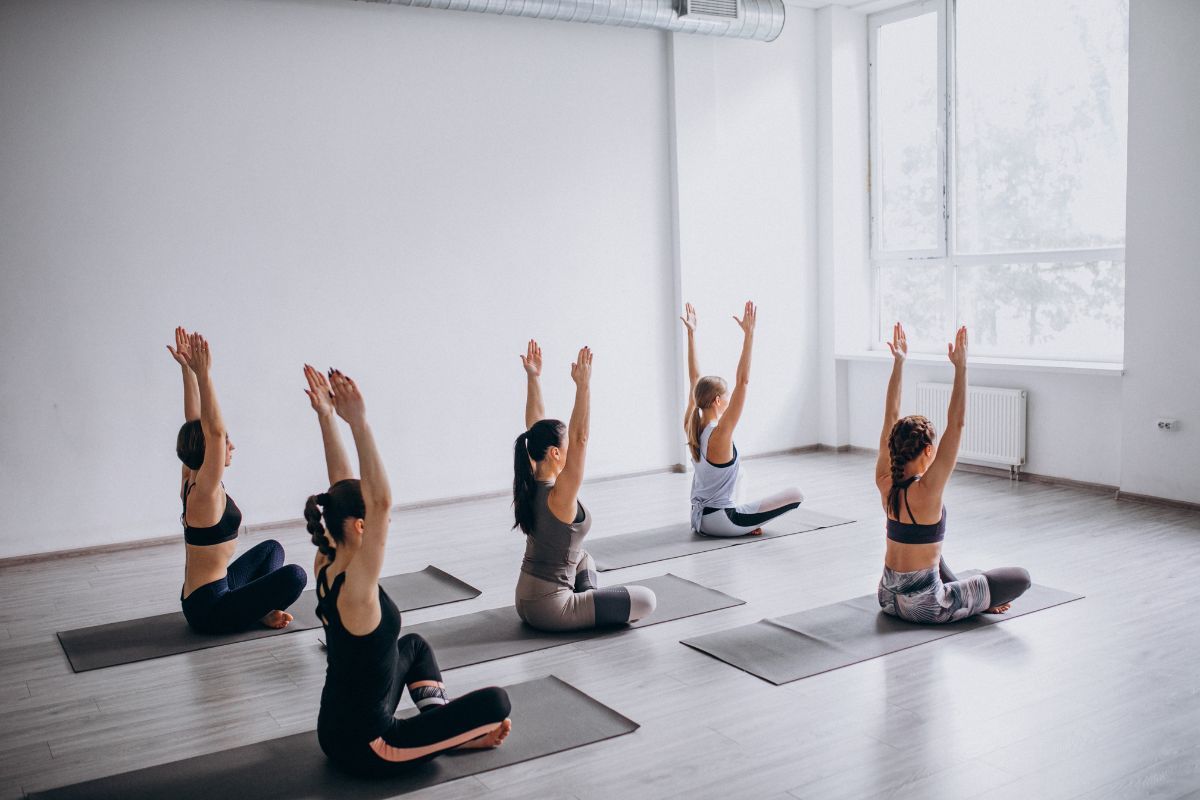
Source: senivpetro on Freepik
Preparing for advanced yoga poses
So, you’re ready to level up your yoga practice with advanced poses? That’s amazing! But before you jump straight into handstands and scorpion poses, let’s talk about preparation. Advanced yoga isn’t just about being bendy or strong—it’s about balance, control, and mindfulness. Here’s how to get yourself ready.
Warm-up: The foundation of every advanced pose
Jumping into deep backbends or tricky arm balances without warming up is like trying to run a marathon without stretching—it’s a recipe for disaster. Here are some essential warm-up moves to prep your body:
- Sun salutations (Surya Namaskar): The perfect full-body warm-up that gets your blood flowing and wakes up your muscles. Do at least 3-5 rounds.
- Dynamic stretches: Move through lunges, shoulder rolls, and gentle spinal twists to loosen up tight areas.
- Joint mobility exercises: Roll out your wrists, ankles, and shoulders—these small movements make a huge difference when holding weight in arm balances or deepening flexibility.
Strength & flexibility prerequisites
Advanced poses demand a combination of strength, flexibility, and balance. Here’s what to focus on:
- Core strength – Essential for inversions and balancing poses. Try planks, boat pose, and hollow body holds to build stability.
- Upper body strength – You’ll need strong arms and shoulders for poses like crow and handstands. Incorporate chaturangas, push-ups, and dolphin holds into your routine.
- Hip & hamstring flexibility – For deep backbends and splits, work on lunges, pigeon pose, and seated forward folds to gradually open up.
- Spinal mobility – Advanced twists and backbends require a supple spine. Include cobra pose, cat-cow, and bridge pose in your practice.
- Balance & proprioception – Standing and arm balances require coordination and awareness. Practice tree pose, warrior III, and forearm balances to refine your control.
Mindset & breath control (Pranayama)
Strength and flexibility will only get you so far—your breath and mindset will carry you through challenging poses.
- Controlled breathing (Ujjayi Breath): Helps maintain focus and endurance, even in difficult postures.
- Patience over perfection: It’s okay if you can’t nail a pose today. Yoga is a journey—progress happens gradually, not overnight.
- Mind-body connection: Pay attention to how your body feels in each pose, and avoid forcing movements that don’t feel right.
Categories of advanced yoga poses
Alright, now that you’re warmed up and ready, it’s time to dive into the advanced poses! To make it easier to navigate, I’ve grouped these poses into different categories based on the skills they challenge—arm balances, backbends, twists, leg-intensive poses, and extreme flexibility transitions.
Each category will push a different aspect of your practice, whether it’s strength, flexibility, balance, or endurance. Some poses require a strong core and upper body, while others demand deep spinal mobility or next-level flexibility.
A quick heads-up: not all advanced poses are created equal. Some may come easier to you than others, depending on your body’s natural abilities and the areas you’ve trained the most. The key? Approach each pose with patience and mindfulness—progress takes time!
Let’s break it down!
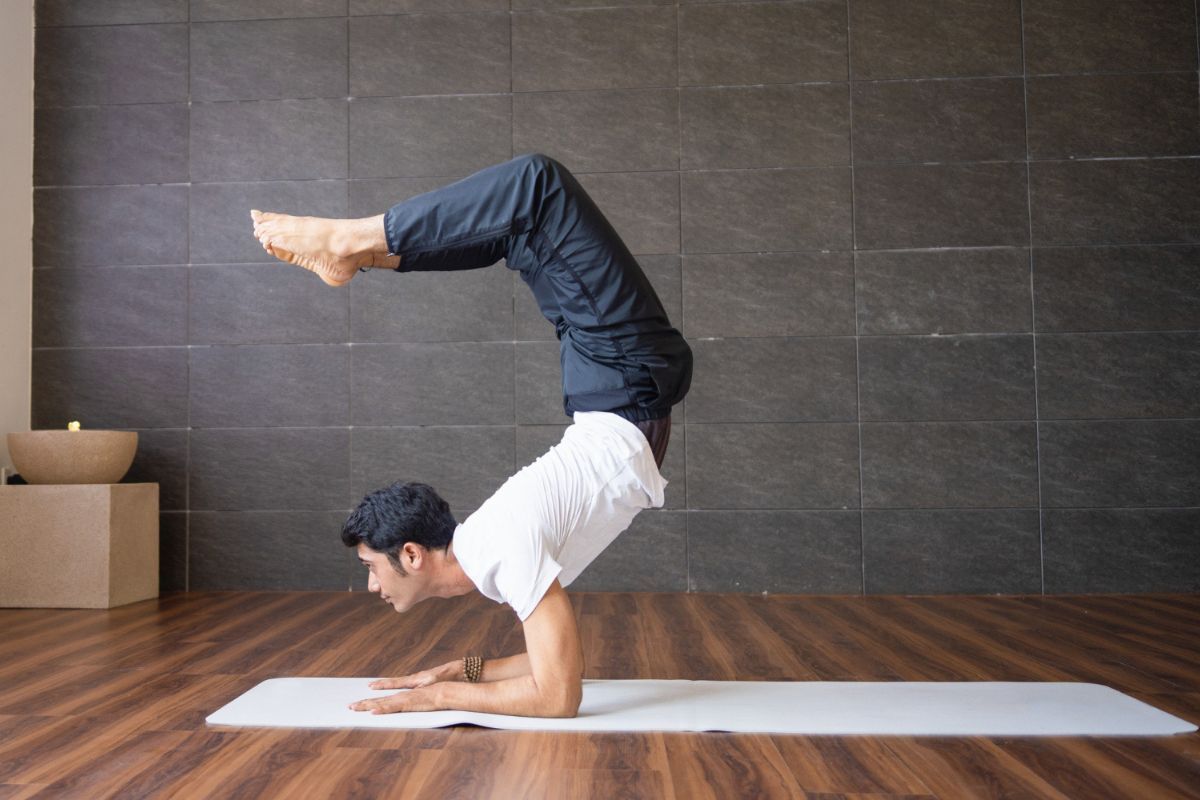
Source: katemangostar on Freepik
A. Arm balances & inversions
Strength, Balance, and a Dash of Courage
Arm balances and inversions are some of the coolest (and most Instagram-worthy) poses in yoga—but they’re not just for show. These advanced poses challenge your upper body strength, core stability, and focus. They’re the perfect blend of strength and grace, helping you build confidence on (and off) the mat.
The poses:
1. Crow Pose (Bakasana)
The gateway to arm balances. Crow pose helps build strength in your arms, shoulders, and core.
How to do it:
- Start in a low squat with your knees wide and hands firmly planted on the mat.
- Lean forward, lifting your hips as you shift your weight onto your arms.
- Gaze forward and lift one foot at a time, eventually balancing on your hands.
Tip: Squeeze your knees into your upper arms and engage your core for stability.
✅ Benefit: Improves wrist and arm strength while teaching balance and control.
2. Flying Pigeon (Eka Pada Galavasana)
A mix of arm balance and hip flexibility.
How to do it:
- Start in a standing figure-four pose with your right ankle over your left knee.
- Bend your standing leg and plant your hands on the ground.
- Lean forward, hook your foot around your upper arm, and lift your back leg.
Tip: Keep your gaze forward and breathe steadily. Flex your foot to stay balanced.
✅ Benefit: Opens the hips, strengthens arms and core, and challenges focus.
3. Eight-Angle Pose (Astavakrasana)
This pose looks complicated but feels empowering once you get the hang of it.
How to do it:
- Sit with your right leg extended and your left leg bent. Hook your left foot over your right arm.
- Plant your hands on the mat and lift your hips off the ground.
- Extend your legs to the side and squeeze your core to stay lifted.
Tip: Engage your obliques and press firmly into your hands.
✅ Benefit: Builds core stability, arm strength, and hip flexibility.
4. Firefly Pose (Tittibhasana)
A challenging pose that requires hamstring flexibility and arm strength.
How to do it:
- Start in a wide-legged forward fold.
- Place your hands under your thighs and shift your weight forward.
- Lift your legs off the ground and straighten them forward, balancing on your arms.
Tip: Keep your core engaged and look forward to maintain balance.
✅ Benefit: Increases hip and hamstring flexibility, strengthens wrists and shoulders.
5. Side Crow (Parsva Bakasana)
Adds a twist to the traditional crow pose.
How to do it:
- Begin in a low squat and twist your torso to the right.
- Plant your hands on the mat and lean forward, balancing your body on your right arm.
- Lift your feet off the ground and hold.
Tip: Engage your obliques and keep your core tight for better control.
✅ Benefit: Strengthens core muscles, improves spinal flexibility, and enhances focus.
6. Peacock Pose (Mayurasana)
A unique pose that challenges your wrist strength and core stability.
How to do it:
- Kneel on the mat and place your palms together with your fingers pointing backward.
- Lean forward, resting your torso on your elbows.
- Extend your legs straight behind you, balancing on your hands.
Tip: Keep your body straight like a plank and engage your core.
✅ Benefit: Strengthens wrists, forearms, and shoulders, improves digestion.
7. One-Handed Peacock (Eka Hasta Mayurasana)
An advanced version of peacock pose that requires intense focus and strength.
How to do it:
- Start in peacock pose, then shift your weight onto one hand.
- Lift the other hand off the ground and balance.
Tip: Practice with a wall nearby for safety.
✅ Benefit: Improves wrist and arm strength, builds extreme balance control.
8. Handstand (Adho Mukha Vrksasana)
The ultimate inversion for strength and balance.
How to do it:
- Start in downward dog. Walk your feet closer to your hands.
- Kick up one leg at a time, engaging your core to stabilize.
- Stack your shoulders over your wrists and hold.
Tip: Practice against a wall until you build confidence.
✅ Benefit: Enhances shoulder strength, balance, and body control.
9. Forearm Stand (Pincha Mayurasana)
A graceful inversion that builds shoulder and core strength.
How to do it:
- Start in dolphin pose (forearms on the mat, hips lifted).
- Kick up one leg at a time, balancing on your forearms.
- Engage your core to keep your legs lifted.
Tip: Press into your forearms and keep your gaze slightly forward.
✅ Benefit: Strengthens shoulders and upper back, improves focus and circulation.
10. Scorpion Pose (Vrschikasana)
An advanced pose that combines a forearm stand with a deep backbend.
How to do it:
- Begin in a forearm stand. Slowly arch your back and bend your knees.
- Lower your feet towards your head, creating a scorpion-like shape.
Tip: Focus on engaging your core and maintaining balance. Use a wall for support while learning.
✅ Benefit: Enhances spinal flexibility, balance, and shoulder strength.
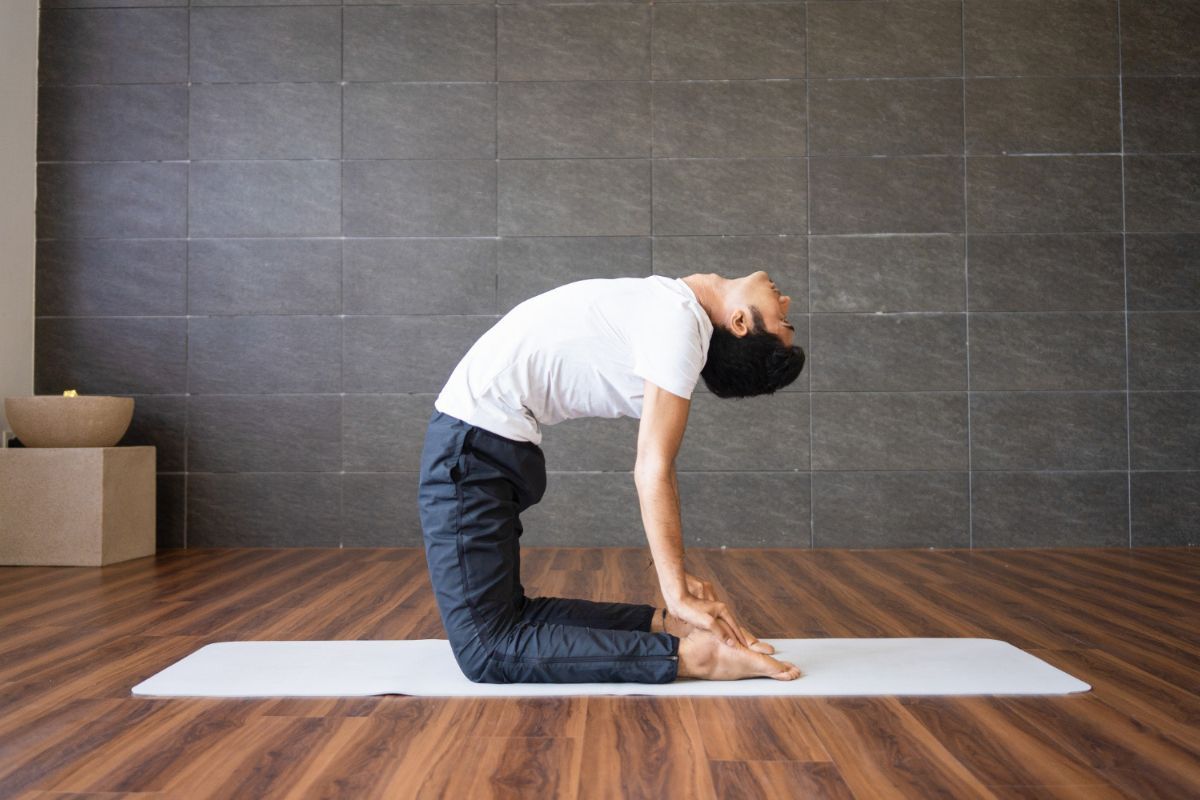
Source: katemangostar on Freepik
B. Deep backbends
Unlock Your Spine’s Full Potential
Backbends are some of the most energizing and transformative poses in yoga. They increase spinal flexibility, open the chest, strengthen the back muscles, and improve posture.
These poses also stimulate the nervous system, boost circulation, and help release emotional tension stored in the body.
If you spend a lot of time sitting at a desk (hello, tight shoulders and stiff lower back!), deep backbends can help counteract poor posture and restore mobility. But they require patience—forcing your way into a deep bend can lead to injury. Instead, focus on gradual progress, proper alignment, and controlled breathing.
The poses:
1. Wheel Pose (Urdhva Dhanurasana)
A full-body backbend that strengthens the arms, legs, and spine.
How to do it:
- Lie on your back with your knees bent and feet hip-width apart.
- Place your hands near your shoulders, fingers pointing towards your feet.
- Press into your hands and feet, lifting your body into a full arch.
Tip: Engage your glutes and press your chest forward rather than just pushing up.
✅ Benefit: Strengthens the back, shoulders, and legs while improving spinal flexibility.
2. King Pigeon Pose (Eka Pada Rajakapotasana)
A deep hip opener combined with an intense backbend.
How to do it:
- Start in pigeon pose with one leg bent in front and the other extended behind.
- Bend your back knee and reach for your foot with both hands.
- Arch your back and bring your foot toward your head.
Tip: Keep your hips squared to avoid unnecessary strain on the lower back.
✅ Benefit: Opens the hips, stretches the quads, and strengthens the back.
3. Bow Pose (Dhanurasana)
A powerful backbend that increases flexibility in the spine and chest.
How to do it:
- Lie on your stomach and reach back to grab your ankles.
- Kick your feet into your hands, lifting your chest and thighs off the mat.
- Breathe deeply and hold.
Tip: Avoid splaying your knees too wide—keep them hip-width apart for stability.
✅ Benefit: Improves spinal flexibility and opens the chest, shoulders, and thighs.
4. Camel Pose (Ustrasana) – Advanced Variation
A deep stretch for the entire front body.
How to do it:
- Kneel on the mat with your knees hip-width apart.
- Place your hands on your heels and push your hips forward while arching your back.
- Drop your head back gently and hold the pose.
Tip: If you feel strain in your lower back, engage your core and lengthen your spine.
✅ Benefit: Expands the rib cage, strengthens the back, and increases spinal mobility.
5. Scorpion in Forearm Stand (Vrschikasana Variation)
A stunning combination of inversion and backbend.
How to do it:
- Start in a forearm stand.
- Slowly bend your knees and arch your back, bringing your feet toward your head.
- Keep control by engaging your core.
Tip: Use a wall for support when learning this pose.
✅ Benefit: Enhances spinal flexibility, balance, and shoulder strength.
6. Full Cobra Pose (Bhujangasana Variation)
An intense chest opener that strengthens the back.
How to do it:
- Lie on your stomach with hands under your shoulders.
- Push up, straightening your arms completely while keeping your legs on the ground.
- Roll your shoulders back and lift your chest.
Tip: Avoid locking your elbows—keep a slight bend.
✅ Benefit: Strengthens the spine and relieves lower back tension.
7. Hollowback Handstand
An advanced inversion that requires strength and flexibility.
How to do it:
- Kick up into a handstand.
- Arch your back and bring your legs forward into a hollow shape.
- Maintain control and breathe deeply.
Tip: Practice near a wall for stability.
✅ Benefit: Builds core strength, shoulder stability, and spinal flexibility.
8. Dancer’s Pose (Natarajasana) – Advanced Variation
A beautiful pose that combines balance, strength, and flexibility.
How to do it:
- Stand on one leg and reach back for your opposite foot.
- Lift your foot toward the ceiling while extending your free arm forward.
- Keep your chest lifted and spine engaged.
Tip: Keep your hips squared to maintain balance.
✅ Benefit: Enhances leg strength, balance, and chest flexibility.
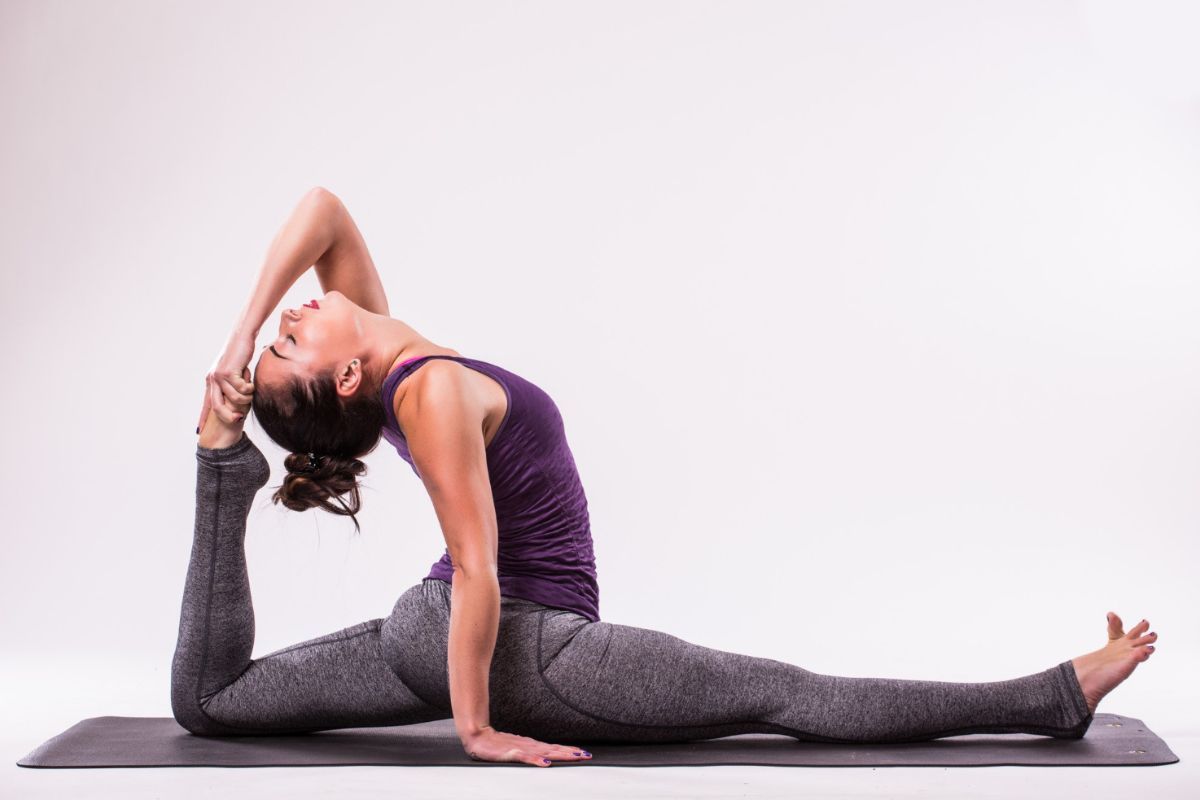
Source: diana.grytsku on Freepik
C. Twists & hip openers
Unlock Mobility & Detoxify the Body
Twists and hip openers are essential for deepening flexibility, improving mobility, and relieving tension—especially if you sit for long hours or feel tight in the lower back and hips. These poses not only increase spinal rotation and improve posture but also stimulate digestion and help detoxify the body by squeezing and massaging the abdominal organs.
Many advanced yoga poses require open hips and a mobile spine, so mastering these movements will prepare you for more complex transitions and deep bends. Twists help improve spinal mobility, while hip openers release tightness in the lower body, allowing for smoother and more fluid movement in your practice.
The poses:
1. Compass Pose (Parivrtta Surya Yantrasana)
An advanced seated twist that requires hamstring flexibility and spinal rotation.
How to do it:
- Sit with one leg extended and the other bent.
- Hook your bent leg over your shoulder and extend it upward.
- Twist your torso and gaze upward, keeping the chest open.
Tip: Keep your spine long and avoid hunching the shoulders.
✅ Benefit: Opens the shoulders, hamstrings, and hips while improving spinal mobility.
2. Revolved Side Angle Pose (Parivrtta Parsvakonasana)
A deep twist that strengthens the legs and core while improving spinal rotation.
How to do it:
- Start in a lunge position with your right foot forward.
- Place your left elbow outside your right knee, twisting your torso.
- Press your palms together and hold the pose.
Tip: Engage your core to avoid collapsing into the twist.
✅ Benefit: Strengthens the legs and core while detoxifying the organs.
3. Bharadvaja’s Twist (Bharadvajasana)
A calming seated twist that improves spinal flexibility and digestion.
How to do it:
- Sit with your legs folded to one side.
- Twist your torso toward the opposite side, placing your hand behind you for support.
- Breathe deeply and hold.
Tip: Keep your spine upright to maximize the twist.
✅ Benefit: Relieves lower back tension and aids digestion.
4. Lotus Pose (Padmasana) – Arm Balance Variation
A classic meditative pose with an advanced arm balance twist.
How to do it:
- Sit in lotus pose with both feet resting on opposite thighs.
- Place your hands on the ground and lift your body using arm strength.
Tip: Ensure your hips are fully open before attempting the lift.
✅ Benefit: Enhances hip mobility and strengthens the core and arms.
5. Fire Log Pose (Agnistambhasana) – Forward Fold Variation
A deep hip-opening pose that relieves tension in the lower body.
How to do it:
- Stack one shin on top of the other, keeping both feet flexed.
- Lean forward for a deeper stretch.
Tip: If your top knee is too high, place a block under it for support.
✅ Benefit: Stretches the outer hips, glutes, and thighs.
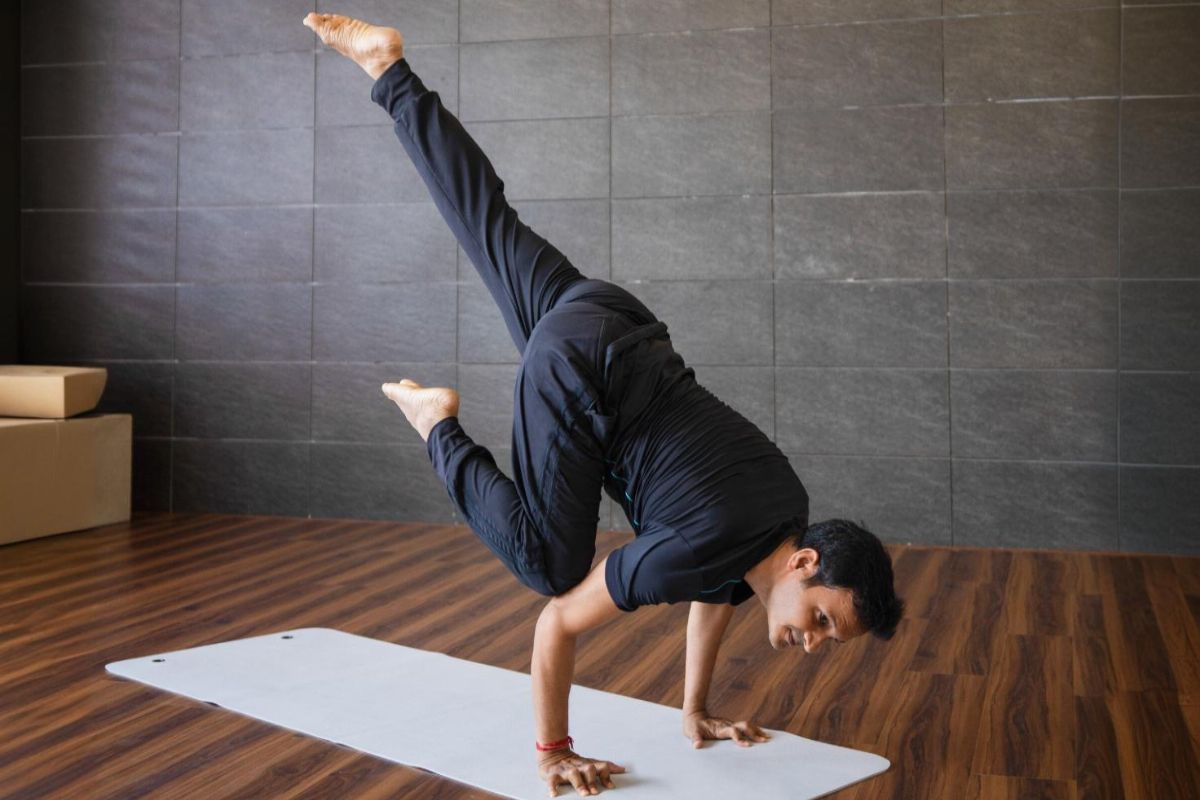
Source: katemangostar on Freepik
D. Leg & core-intensive poses
Power, Stability, and Endurance
If you’ve ever held a long warrior pose and felt your legs shake like a leaf in the wind, you know that yoga is more than just flexibility—it’s about strength, endurance, and total-body control. Advanced leg- and core-intensive poses take this to the next level, requiring a blend of stability, mobility, and sheer determination.
These poses build lower-body power, core engagement, and overall endurance, helping you move with more control and precision in every aspect of your practice. Whether you want to strengthen your standing poses, improve your inversions, or refine your transitions, focusing on leg and core strength is the key.
The poses:
1. Bird of Paradise (Svarga Dvijasana)
A challenging standing pose that combines balance, flexibility, and strength.
How to do it:
- Start in extended side angle pose, then reach your bottom arm under your thigh and clasp your hands behind your back.
- Shift your weight onto your standing leg and slowly lift your other leg straight up.
Tip: Engage your core and keep your lifted leg strong to maintain balance.
✅ Benefit: Improves leg strength, hip mobility, and coordination.
2. Standing Splits (Urdhva Prasarita Eka Padasana)
A deep hamstring stretch and test of leg and core control.
How to do it:
- From a standing forward fold, lift one leg high behind you while keeping the standing leg strong.
- Keep your hands on the ground or reach for your ankle for a deeper stretch.
Tip: Keep your hips squared to avoid collapsing into one side.
✅ Benefit: Builds hamstring flexibility, balance, and leg endurance.
3. Super Soldier Pose
A deep hamstring and balance challenge that looks as cool as it sounds.
How to do it:
- Start in a forward fold and grab your opposite ankle behind your back.
- Lift the opposite leg while balancing on one foot.
Tip: Focus on keeping the core engaged for stability.
✅ Benefit: Increases flexibility while challenging single-leg balance.
4. Visvamitrasana
A full-body strength and flexibility pose named after a warrior sage.
How to do it:
- Start in a side plank, then bring your bottom leg forward and extend it up while holding your foot.
- Keep your hips lifted and chest open.
Tip: Engage your core and press firmly into your supporting hand.
✅ Benefit: Strengthens the arms, core, and legs while improving flexibility.
5. Koundinyasana I & II
A powerful arm balance that requires leg control and core strength.
How to do it:
- Start in a deep twist, placing your hands on the mat.
- Lean forward, lifting both legs and balancing on your arms.
Tip: Keep your core engaged and legs active to stay lifted.
✅ Benefit: Builds arm, core, and leg strength while refining balance.
6. One-Legged Crow
An advanced variation of crow pose that demands core and leg strength.
How to do it:
- Begin in crow pose and slowly extend one leg behind you.
- Keep the other leg bent and balanced on your arms.
Tip: Focus on slow, controlled movements rather than kicking out.
✅ Benefit: Challenges arm balance, core engagement, and leg control.
7. Archer’s Pose (Akarna Dhanurasana)
A seated pose that mimics pulling back a bow, testing flexibility and control.
How to do it:
- Sit with your legs extended, grab one foot, and pull it toward your ear while keeping the other leg straight.
Tip: Keep your back straight to avoid rounding the spine.
✅ Benefit: Stretches hamstrings and strengthens hip flexors.
8. Sleeping Vishnu Pose (Anantasana)
A deceptively challenging pose that requires leg and core engagement.
How to do it:
- Lie on your side, balance on one arm, and lift your top leg while holding your foot.
Tip: Keep your body aligned and resist collapsing into your supporting shoulder.
✅ Benefit: Enhances leg flexibility and core stability.
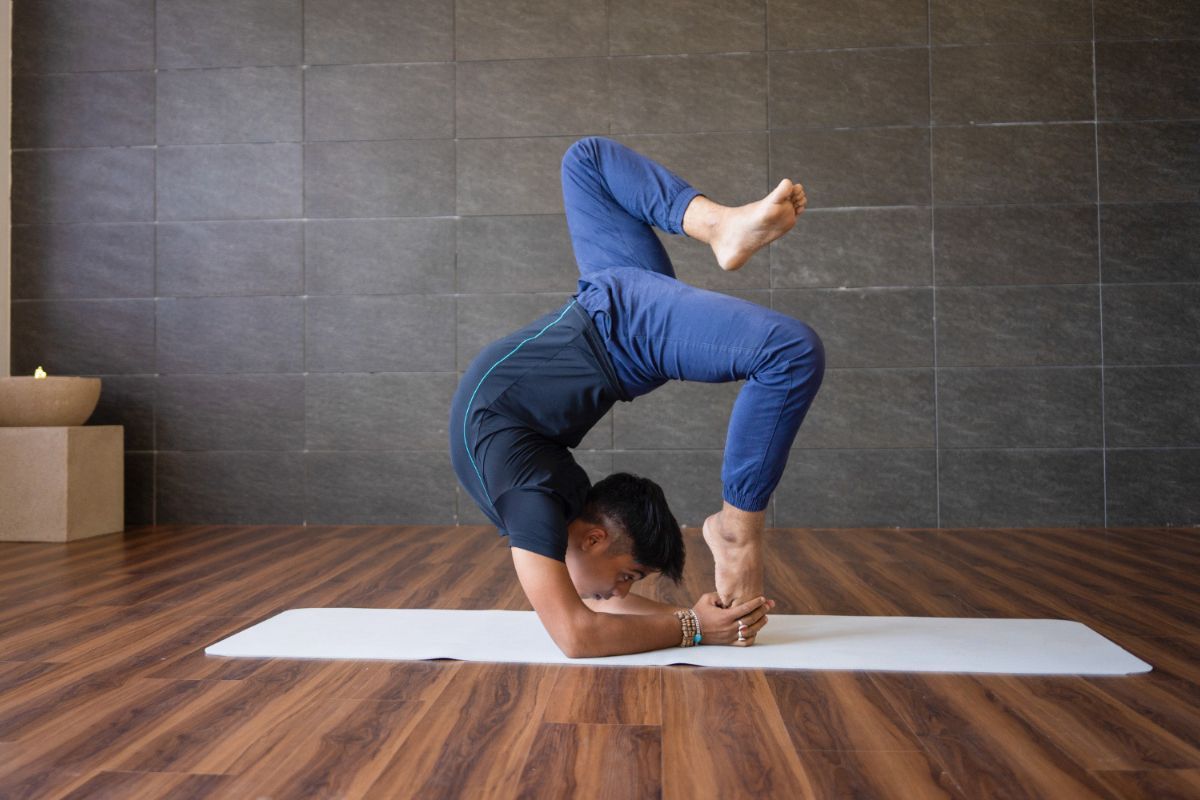
Source: katemangostar on Freepik
E. Extreme flexibility & transitions
Push Your Mobility to the Limits
Advanced yoga isn’t just about strength—it’s also about unlocking next-level flexibility and seamlessly flowing between poses. Extreme flexibility poses test your body’s range of motion, control, and breathwork while requiring deep concentration. These poses demand open hips, a supple spine, and strong yet mobile muscles, making them some of the most challenging but rewarding in yoga.
If you want to move effortlessly between poses, work on gradual deepening and smooth transitions instead of forcing flexibility. These poses aren’t about being hypermobile—they’re about control, awareness, and graceful movement.
The poses:
1. Full King Cobra (Purna Bhujangasana)
A deeper version of Cobra Pose that requires extreme spinal flexibility and strength.
How to do it:
- Lie on your stomach and press into your hands, lifting your chest.
- Bend your knees and reach your feet toward your head, deepening the backbend.
Tip: Engage your glutes and core to avoid straining your lower back.
✅ Benefit: Opens the chest, strengthens the back, and improves spinal mobility.
2. Mermaid Pose (Advanced Pigeon Variation)
An intense hip and spine opener with a graceful finish.
How to do it:
- Start in pigeon pose with your back leg bent.
- Reach back, grab your foot, and place it in the crook of your elbow.
- Lift your opposite arm and clasp your hands behind your head.
Tip: Keep your hips squared to avoid twisting out of alignment.
✅ Benefit: Improves hip flexibility, spinal extension, and chest openness.
3. Chin Stand (Ganda Bherundasana)
A pose that tests balance, shoulder strength, and spinal flexibility.
How to do it:
- Start in a low plank, shift your weight forward, and rest your chin on the mat.
- Lift your legs, engaging your core to balance.
Tip: Use a controlled lift rather than kicking up too quickly.
✅ Benefit: Strengthens the upper body and enhances backbend depth.
4. Flying Splits (Hanumanasana Variation)
A split variation that challenges hamstring flexibility and core control.
How to do it:
- From a lunge, lower into a full split.
- Shift your weight forward and lift your arms, keeping your core engaged.
Tip: Use blocks for support while building flexibility.
✅ Benefit: Increases hamstring and hip flexibility while strengthening balance.
Conclusion
So, there you have it—35 advanced yoga poses to take your practice to the next level! If you’ve made it this far, give yourself some serious credit.
Now, let’s get real for a second—advanced yoga isn’t about just hitting the “cool” poses or showing off on Instagram (though, let’s be honest, they do look pretty epic). It’s about building strength, flexibility, patience, and a deeper connection with your body. It’s about pushing past mental blocks, trusting yourself, and enjoying the process, even when progress feels slow.
And let’s not forget the most important part—yoga is meant to feel good. Some of these poses might take weeks, months, or even years to master, and that’s totally fine. The magic happens in the small wins: the extra second you hold an arm balance, the deeper breath you take in a twist, the confidence you build every time you step onto your mat.
So, what’s next? Keep practicing, stay consistent, and most importantly—have fun with it! Mix in some playful challenges, listen to your body, and celebrate your progress, no matter how small. Advanced yoga isn’t just about strength and flexibility—it’s about the joy of movement and the journey of self-discovery.
Now go roll out your mat, give some of these poses a shot, and keep leveling up!
Friska 🐨
Read next: Yoga for constipation: 5 poses for relief
.jpg)
